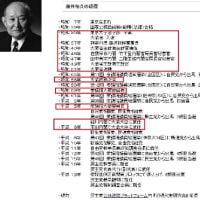
Japan Supreme Court's Second Petit Bench found three antiwar activists guilty of trespassing when they entered a housing compound of the Self-Defense Forces in Tachikawa(http://search.japantimes.co.jp/cgi-bin/ed20080427a1.html).A full text of Japan Supreme Court's decision is as below.How do you think about the decision?
■ ■ ■ vol.2 ■ ■ ■
Main text of the judgment
The final appeals are dismissed.
Reasons
I. Concerning the reason for final appeal argued by the appeal counsels for the three accused persons, KURIYAMA Reiko, et al., alleging that charging the accused with the crime set forth in the first sentence of Article 130 of the Penal Code for what they have done contravenes Article 21, paragraph (1) of the Constitution
1. According to the findings and records of the judgment of prior instance, the outline of the case is as follows.
(1) Situation of the Tachikawa Housing Complex, etc.
(a) Overall situation
The Tachikawa Housing Complex of the Defense Agency (then; hereinafter the same) located in Tachikawa City, Tokyo (hereinafter referred to as the "Tachikawa Housing Complex") stands on a reverse L-shaped site consisting of a narrow rectangular strip of land stretching from north to south (about 400 meters long from north to south and about 50 meters wide from east to west; hereinafter referred to as the "southern site") with another narrow rectangular strip of land adjacent to the northern end of the former, which stretches from east to west (about 25 meters wide from north to south and about 130 meters long from east to west; hereinafter referred to as the "northern site") and extends westward. The eastern side of the southern site and the eastern side and northern side of the northern site face public roads, and the western side of the southern site and the western side and the western half of the southern side of the northern site border on the Self-Defense Forces (SDF) Camp Higashi Tachikawa. On the southern half of the southern site, a housing complex consisting of eight buildings stands, from Building No. 1 to Building No. 8 in line from south to north. Each building is a slender rectangular reinforced four-story building, having six residential units on each floor (each building stands on a lot of about 200 meters long in the north-south direction). The northern half of the southern site is a rectangular vacant lot stretching from north to south (hereinafter referred to as the "northern vacant lot"). On the northern site, a similar housing complex stands, consisting of Building No. 9 and Building No. 10 in line from east to west. Both Building No. 9 and Building No. 10 have five stories respectively, and Building No. 10 has eight residential units on each floor.
(b) The state of enclosure of the site of Tachikawa Housing Complex
(A) The site on which Building No. 1 to Building No. 8 stand is surrounded by: iron fences each of which is about 1.5 meter high on the south side; iron fences or metal netting fences each of which is about 1.5 to 1.6 meters high on the east side which faces a public road; wooden posts on the north side which borders on the northern vacant lot; and iron fences each of which is about 1.85 to 2.1 meters high on the west side which borders on the SDF Camp Higashi Tachikawa, with an entrance gate with a door. The fences on the east side have openings that serve as gateways without doors leading to the northern passages of Building No. 1 to Building No. 8, the widths of which are about 7.1 meters, about 5.9 meters, about 8 meters, about 6.1 meters, about 6.3 meters, about 5 meters, about 9 meters, and about 6.1 meters, respectively. Four iron wires are strung over the wooden posts on the north side, at almost equal intervals.
(B) The site on which Building No. 9 and Building No. 10 stand is also surrounded by metal netting fences or iron fences each of which is about 1.5 to 1.7 meters high. The fences on the east and north sides that face public roads have openings that serve as gateways for the buildings, the widths of which are a few meters to about 8.2 meters, respectively, and which have no doors.
(c) Condition of the guide boards, etc. standing on the site of the Tachikawa Housing Complex
(A) Near the opening on the fences on the east side of the site of Building No. 1 to Building No. 8, which serves as a gateway leading to the northern passage of Building 1, stands a guide board entitled "Guide Map of the Tachikawa Housing Complex of the Defense Agency." Also, on the left of the openings on the fences on the east side of said site that lead to the northern passages of the respective buildings, there are warning boards covered with vinyl sheets. On each board, a white A3-sized landscape sheet of paper is attached, on which the following instructions are written vertically:
The following is prohibited within the area of the housing complex:
- Entering the area without authorization
- Posting or distributing leaflets and other propaganda activities
- Selling goods by opening stalls (occupying the land) or peddling
- Parking vehicles
- Being a nuisance to others
Managers
(B) Near the opening on the fences surrounding the site of Building No. 9 and Building No. 10 mentioned in (b)(B), which serves as a gateway for Building 9, stands the same guide board as that mentioned above, entitled "Guide Map of the Tachikawa Housing Complex of the Defense Agency." Also on the left or right of the openings on these fences that serve as gateways for the respective buildings, the same warning boards as those mentioned above are placed.
(d) Condition of each building
(A) Each of Building No. 1 to Building No. 9 has an eastern staircase, central staircase, and western staircase. On the north side of the first floor of each building, there are three gateways without doors that lead to the respective staircases. On the north side of the first floor of Building No. 10, there are four gateways without doors that lead to the eastern staircase, eastern central staircase, western central staircase, and western staircase, respectively. At these gateways, collective mailboxes are placed. In front of these staircases, there are entrances of two residential units on each floor, and a newspaper box is installed on the entrance door of each residential unit.
(B) On the notice boards placed at the gateways on the first floor of Building No. 1 to Building No. 10 or on the walls above the collective mailboxes, warning notices are put up, some covered with vinyl sheets. Each notice is a white or yellow A4-sized landscape sheet of paper, on which the same instructions as those written on the aforementioned warning boards are written vertically.
(e) Management of the Tachikawa Housing Complex
The Tachikawa Housing Complex is a housing complex established by the State as residences for the officials of the Defense Agency and their families. At the time of the incident, almost all units were occupied in Building No. 1 to Building No. 8. Under the Act on Housing Complexes for National Public Servants, Order for Enforcement of said Act and other relevant laws and regulations, the entire site as well as Building No. 5 to Building No. 8 are under the management of the Commander of the Japan Ground Self-Defense Forces (JGSDF) Camp Higashi Tachikawa, Building No. 1 to Building No. 4 are under the management of the director of the Tachikawa Branch of the First Depot of the Japan Air Self-Defense Forces (JASDF), and Building No. 9 and Building No. 10 are under the management of the Contract Department of the Defense Agency or the Third Laboratory of the Technical Research Department of said Agency.
(2) Content of the activities of the Tachikawa SDF Monitoring Tent Village
The Tachikawa SDF Monitoring Tent Village (hereinafter referred to as the "Tent Village") is a group formed on the occasion of the relocation of the SDF camp to the Tachikawa Base of the United States Forces. The group, advocating antiwar and pacifism, carries out various activities such as holding demonstrations, distributing information to the public in front of train stations, and making requests to the SDF camp. The three accused are members of the Tent Village.
→vol.3 http://blog.goo.ne.jp/tokyodo-2005/e/23ef4eefe83e07d1efd4092ad735b663
vol.1 http://blog.goo.ne.jp/tokyodo-2005/e/b15bf213e32f2b439c876cb510cc5906
vol.2 http://blog.goo.ne.jp/tokyodo-2005/e/8df853cd075778ccf778202c4d6db558
voi.3 http://blog.goo.ne.jp/tokyodo-2005/e/23ef4eefe83e07d1efd4092ad735b663
vol.4 http://blog.goo.ne.jp/tokyodo-2005/e/6d525bf8c7c478e7ff3f5f10b4e79f54
■ ■ ■ vol.2 ■ ■ ■
Main text of the judgment
The final appeals are dismissed.
Reasons
I. Concerning the reason for final appeal argued by the appeal counsels for the three accused persons, KURIYAMA Reiko, et al., alleging that charging the accused with the crime set forth in the first sentence of Article 130 of the Penal Code for what they have done contravenes Article 21, paragraph (1) of the Constitution
1. According to the findings and records of the judgment of prior instance, the outline of the case is as follows.
(1) Situation of the Tachikawa Housing Complex, etc.
(a) Overall situation
The Tachikawa Housing Complex of the Defense Agency (then; hereinafter the same) located in Tachikawa City, Tokyo (hereinafter referred to as the "Tachikawa Housing Complex") stands on a reverse L-shaped site consisting of a narrow rectangular strip of land stretching from north to south (about 400 meters long from north to south and about 50 meters wide from east to west; hereinafter referred to as the "southern site") with another narrow rectangular strip of land adjacent to the northern end of the former, which stretches from east to west (about 25 meters wide from north to south and about 130 meters long from east to west; hereinafter referred to as the "northern site") and extends westward. The eastern side of the southern site and the eastern side and northern side of the northern site face public roads, and the western side of the southern site and the western side and the western half of the southern side of the northern site border on the Self-Defense Forces (SDF) Camp Higashi Tachikawa. On the southern half of the southern site, a housing complex consisting of eight buildings stands, from Building No. 1 to Building No. 8 in line from south to north. Each building is a slender rectangular reinforced four-story building, having six residential units on each floor (each building stands on a lot of about 200 meters long in the north-south direction). The northern half of the southern site is a rectangular vacant lot stretching from north to south (hereinafter referred to as the "northern vacant lot"). On the northern site, a similar housing complex stands, consisting of Building No. 9 and Building No. 10 in line from east to west. Both Building No. 9 and Building No. 10 have five stories respectively, and Building No. 10 has eight residential units on each floor.
(b) The state of enclosure of the site of Tachikawa Housing Complex
(A) The site on which Building No. 1 to Building No. 8 stand is surrounded by: iron fences each of which is about 1.5 meter high on the south side; iron fences or metal netting fences each of which is about 1.5 to 1.6 meters high on the east side which faces a public road; wooden posts on the north side which borders on the northern vacant lot; and iron fences each of which is about 1.85 to 2.1 meters high on the west side which borders on the SDF Camp Higashi Tachikawa, with an entrance gate with a door. The fences on the east side have openings that serve as gateways without doors leading to the northern passages of Building No. 1 to Building No. 8, the widths of which are about 7.1 meters, about 5.9 meters, about 8 meters, about 6.1 meters, about 6.3 meters, about 5 meters, about 9 meters, and about 6.1 meters, respectively. Four iron wires are strung over the wooden posts on the north side, at almost equal intervals.
(B) The site on which Building No. 9 and Building No. 10 stand is also surrounded by metal netting fences or iron fences each of which is about 1.5 to 1.7 meters high. The fences on the east and north sides that face public roads have openings that serve as gateways for the buildings, the widths of which are a few meters to about 8.2 meters, respectively, and which have no doors.
(c) Condition of the guide boards, etc. standing on the site of the Tachikawa Housing Complex
(A) Near the opening on the fences on the east side of the site of Building No. 1 to Building No. 8, which serves as a gateway leading to the northern passage of Building 1, stands a guide board entitled "Guide Map of the Tachikawa Housing Complex of the Defense Agency." Also, on the left of the openings on the fences on the east side of said site that lead to the northern passages of the respective buildings, there are warning boards covered with vinyl sheets. On each board, a white A3-sized landscape sheet of paper is attached, on which the following instructions are written vertically:
The following is prohibited within the area of the housing complex:
- Entering the area without authorization
- Posting or distributing leaflets and other propaganda activities
- Selling goods by opening stalls (occupying the land) or peddling
- Parking vehicles
- Being a nuisance to others
Managers
(B) Near the opening on the fences surrounding the site of Building No. 9 and Building No. 10 mentioned in (b)(B), which serves as a gateway for Building 9, stands the same guide board as that mentioned above, entitled "Guide Map of the Tachikawa Housing Complex of the Defense Agency." Also on the left or right of the openings on these fences that serve as gateways for the respective buildings, the same warning boards as those mentioned above are placed.
(d) Condition of each building
(A) Each of Building No. 1 to Building No. 9 has an eastern staircase, central staircase, and western staircase. On the north side of the first floor of each building, there are three gateways without doors that lead to the respective staircases. On the north side of the first floor of Building No. 10, there are four gateways without doors that lead to the eastern staircase, eastern central staircase, western central staircase, and western staircase, respectively. At these gateways, collective mailboxes are placed. In front of these staircases, there are entrances of two residential units on each floor, and a newspaper box is installed on the entrance door of each residential unit.
(B) On the notice boards placed at the gateways on the first floor of Building No. 1 to Building No. 10 or on the walls above the collective mailboxes, warning notices are put up, some covered with vinyl sheets. Each notice is a white or yellow A4-sized landscape sheet of paper, on which the same instructions as those written on the aforementioned warning boards are written vertically.
(e) Management of the Tachikawa Housing Complex
The Tachikawa Housing Complex is a housing complex established by the State as residences for the officials of the Defense Agency and their families. At the time of the incident, almost all units were occupied in Building No. 1 to Building No. 8. Under the Act on Housing Complexes for National Public Servants, Order for Enforcement of said Act and other relevant laws and regulations, the entire site as well as Building No. 5 to Building No. 8 are under the management of the Commander of the Japan Ground Self-Defense Forces (JGSDF) Camp Higashi Tachikawa, Building No. 1 to Building No. 4 are under the management of the director of the Tachikawa Branch of the First Depot of the Japan Air Self-Defense Forces (JASDF), and Building No. 9 and Building No. 10 are under the management of the Contract Department of the Defense Agency or the Third Laboratory of the Technical Research Department of said Agency.
(2) Content of the activities of the Tachikawa SDF Monitoring Tent Village
The Tachikawa SDF Monitoring Tent Village (hereinafter referred to as the "Tent Village") is a group formed on the occasion of the relocation of the SDF camp to the Tachikawa Base of the United States Forces. The group, advocating antiwar and pacifism, carries out various activities such as holding demonstrations, distributing information to the public in front of train stations, and making requests to the SDF camp. The three accused are members of the Tent Village.
→vol.3 http://blog.goo.ne.jp/tokyodo-2005/e/23ef4eefe83e07d1efd4092ad735b663
vol.1 http://blog.goo.ne.jp/tokyodo-2005/e/b15bf213e32f2b439c876cb510cc5906
vol.2 http://blog.goo.ne.jp/tokyodo-2005/e/8df853cd075778ccf778202c4d6db558
voi.3 http://blog.goo.ne.jp/tokyodo-2005/e/23ef4eefe83e07d1efd4092ad735b663
vol.4 http://blog.goo.ne.jp/tokyodo-2005/e/6d525bf8c7c478e7ff3f5f10b4e79f54














